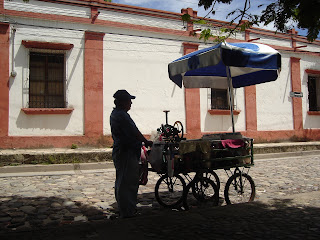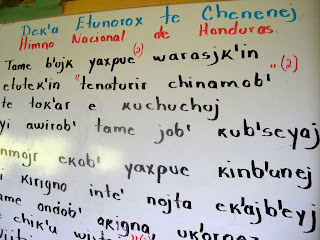 Top to bottom: Leidi, Kenia, Wilmer, Berto. These guys took me on a kid tour around Brisas. Their (new) houses, the kindergarten ("kinder," in the front room of one of the new houses), the trail where they like to play, an orange wheelbarrow. The last stop was the library.
Top to bottom: Leidi, Kenia, Wilmer, Berto. These guys took me on a kid tour around Brisas. Their (new) houses, the kindergarten ("kinder," in the front room of one of the new houses), the trail where they like to play, an orange wheelbarrow. The last stop was the library. Up hill. Probably best describes this round in Honduras. Four months in and we still don't have a building. The books (in empty corn sacks) and some of the furniture is stuffed in a back room in Cecilia's house. The rest of the furniture is in the carpenter's workshop. Some of the books got wet. Only a few of the women really get how to run the library. The teacher never comes to the school in Brisas. A lot of the bean crop has been ruined by the rain.
Whenever I ask Jose Manuel how the project is going, he always says the same thing. "Subimos." Translated, it means "we're progressing" or "we're moving forward." Literally, it means "to rise" or "to go up." And that's what this whole thing has been about. Slowy, I suppose, we are rising up. There are books. There will be a building. It will stop raining.
The rest comes after.

 Outside of Cecilia's house in Brisas. Chickens huddling over the fire pit, under the rusted tin overhang, out of the rain. Whenever it rains, they all get together and watch from the same spot.
Outside of Cecilia's house in Brisas. Chickens huddling over the fire pit, under the rusted tin overhang, out of the rain. Whenever it rains, they all get together and watch from the same spot.



 Laying the level line around the building's perimeter.
Laying the level line around the building's perimeter.

 To the public library in Copan. Everyone's first time visiting a library, of any sort. The idea was for the women to see how a library looks, how it works.
To the public library in Copan. Everyone's first time visiting a library, of any sort. The idea was for the women to see how a library looks, how it works.
 6 women, 12 purses. Everybody finished one practice purse with hands.
6 women, 12 purses. Everybody finished one practice purse with hands.
 Jose Manuel's machete in the trail.
Jose Manuel's machete in the trail.

































